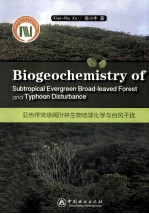图书介绍
亚热带常绿阔叶林生物地球化学与台风干扰 英文pdf电子书版本下载

- 徐小牛著 著
- 出版社: 北京:中国林业出版社
- ISBN:9787503871900
- 出版时间:2013
- 标注页数:208页
- 文件大小:75MB
- 文件页数:280页
- 主题词:亚热带林-常绿阔叶林-生物地球化学-研究-英文;亚热带林-常绿阔叶林-台风-干扰-研究-英文
PDF下载
下载说明
亚热带常绿阔叶林生物地球化学与台风干扰 英文PDF格式电子书版下载
下载的文件为RAR压缩包。需要使用解压软件进行解压得到PDF格式图书。建议使用BT下载工具Free Download Manager进行下载,简称FDM(免费,没有广告,支持多平台)。本站资源全部打包为BT种子。所以需要使用专业的BT下载软件进行下载。如 BitComet qBittorrent uTorrent等BT下载工具。迅雷目前由于本站不是热门资源。不推荐使用!后期资源热门了。安装了迅雷也可以迅雷进行下载!
(文件页数 要大于 标注页数,上中下等多册电子书除外)
注意:本站所有压缩包均有解压码: 点击下载压缩包解压工具
图书目录
1. Introduction 1
1.1 Characteristics of the Okinawan Evergreen Broad-leaved Forest and Its Importance for Sustainable Management 1
1.2 Overview of Nutrient Cycling in Forest Ecosystems 2
1.3 Effects of Typhoon Disturbances on Forest Ecosystems 5
1.4 Motives for the Present Synthesis 7
1.5 The Contents and Organization of the Book 8
1.6 Summary 10
2. Study Site Characterization 11
2.1 Study Area 11
2.2 Climate 11
2.3 Topographic Trait and Soils 13
2.4 Vegetation 14
3. Soil Properties, Organic Carbon, and Nutrient Pools 15
3.1 Introduction 15
3.2 Study Approach 16
3.2.1 Forest Floor and Mineral Soil Sampling 17
3.2.2 Experimental Design in the Study 18
3.2.3 Statistical Analysis and Data Treatment 19
3.3 Forest Floor Mass and Carbon and Nutrient Pools 20
3.3.1 Carbon and Nutrient Pools 20
3.3.2 Topographic Effects 22
3.4 Soil Properties and Carbon and Nutrient Pools 23
3.4.1 Soil Properties 23
3.4.2 Carbon and Nutrient Pools 27
3.4.3 Cluster Analysis of Soil Data 28
3.5 Summary 30
4. Forest Structure, Species Diversity, Regeneration and Primary production 31
4.1 Introduction 31
4.2 Experimental Approach 33
4.2.1 Field Survey 33
4.2.2 Species Diversity Indices 36
4.2.3 Forest Biomass Estimation 37
4.3 Forest Structure and Floristics 42
4.3.1 Structural Characteristics 42
4.3.2 Floristic Composition and Tree Species Diversity 44
4.3.3 Understory Tree Species Diversity 46
4.3.4 Controls of Species Diversity 47
4.3.5 Discussion of Species Diversity 47
4.4 Forest Regeneration Characteristics 49
4.4.1 Stand Density 49
4.4.2 Regeneration Strategies of Canopy Dominants 50
4.4.3 Restoration of Stand Structure 53
4.5 Aboveground Biomass and Nutrient Accumulation 55
4.5.1 Aboveground Biomass 55
4.5.2 Carbon and Nutrient Storage in Biomass 57
4.5.3 Discussion on Biomass Estimation and Nutrient Storage 59
4.6 Summary 60
5. Organic Matter and Nutrient Dynamics in Litter Production 62
5.1 Introduction 62
5.2 Approaches to Forest Litterfall Measurement 63
5.2.1 Litterfall Measurement 63
5.2.2 Chemical Analysis 66
5.2.3 Data Treatment 67
5.3 Litterfall Production 67
5.3.1 Amount and Seasonality of Litterfall 67
5.3.2 Nutrient Inputs by Litterfall 72
5.4 Effects of Typhoon Disturbance on Litterfall and Related Nutrient Input 76
5.5 Discussion 79
5.5.1 Litter Production 79
5.5.2 Nutrient Concentration and Inputs 81
5.5.3 Nutrient Use Efficiency in Litter Production 82
5.5.4 Effects of Typhoon Disturbances 84
5.6 Summary 85
6. Carbon and Nutrient Dynamics in Decomposing Foliar Litter 87
6.1 Introduction 87
6.2 Factors Affecting the Decomposition Process 89
6.2.1 Litter Quality 89
6.2.2 Climate 90
6.2.3 Site-specific Variables 91
6.2.4 Human Activity 92
6.3 Approaches to the Study of Litter Decomposition 92
6.3.1 Mass Balance Method 92
6.3.2 Litterbag Method 93
6.3.3 Experimental Design in the Study 94
6.3.4 Chemical Analysis 96
6.3.5 Data Analysis 97
6.4 Nutrients Dynamics in Decomposing Foliar Litter 97
6.4.1 Weight Loss and Decomposition Rate 97
6.4.2 Initial Foliar Litter Quality 101
6.4.3 Nutrient Dynamics 101
6.5 Discussion 107
6.5.1 Dry Mass Loss and Decomposition Rate 107
6.5.2 Initial Litter Quality and Nutrient Dynamics 108
6.6 Summary 115
7. Nutrient Fluxes in Precipitation, Throughfall, Stemflow and Soil Water 117
7.1 Introduction 117
7.2 Methodology of Study of Forest Hydrology 119
7.2.1 Research Forest Stand 119
7.2.2 Hydrological Measurements 120
7.2.3 Chemical Analysis 122
7.2.4 Data Analysis 123
7.3 Rainfall Partitioning 123
7.3.1 Precipitation and Canopy Interception 123
7.3.2 Surface Runoff and Soil Lateral Flow 126
7.4 Nutrient Fluxes 128
7.4.1 Precipitation, Throughfall and Stemflow 128
7.4.2 Soil Water 131
7.5 Discussion 132
7.5.1 Distribution of Rainfall Components 132
7.5.2 Nutrient Inputs in Precipitation 135
7.6 Summary 138
8. Effects of Typhoon Disturbances on Stream Water Chemistry 139
8.1 Introduction 139
8.2 Methodology in the Study 140
8.3 Temporal Patterns of Stream Water Chemistry 141
8.3.1 Physicochemical Properties of Stream Water 141
8.3.2 Temporal Patterns of Streamwater Chemistry 143
8.3.3 Average Streamwater Concentrations During and After Typhoon Season 147
8.4 Discussion 148
8.4.1 Controls of Streamwater Chemistry 148
8.4.2 Effects of Typhoon Disturbance on Streamwater Chemistry 150
8.5 Summary 152
9. Integration and Opportunities 153
9.1 Within Stand Nutrient Cycling, Nutrient Transfer Pathway, and Nutrient Use Efficiency 153
9.1.1 Nutrient Cycling within the Ecosystem 153
9.1.2 Nutrient Transfer Pathway 157
9.1.3 Nutrient Use Efficiency 158
9.2 Effects of Typhoon Disturbance on Nutrient Cycling 160
9.3 Control of Forest Structure and Productivity 163
9.4 Future Opportunities 167
9.5 Summary 169
References 171
Appendix Ⅰ 205
Appendix Ⅱ 207